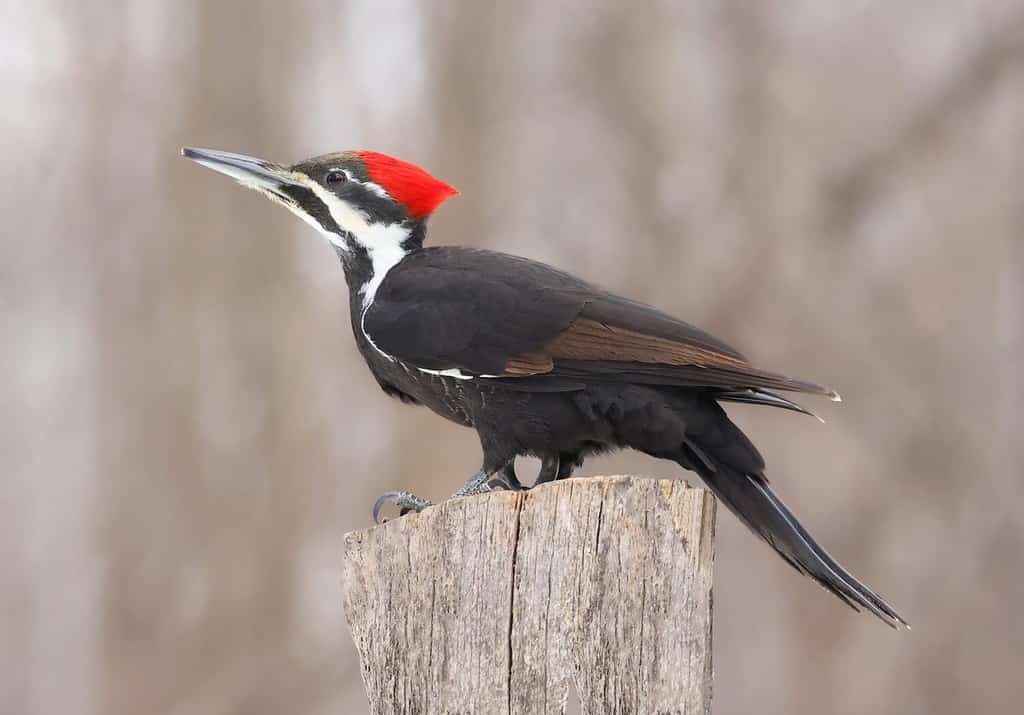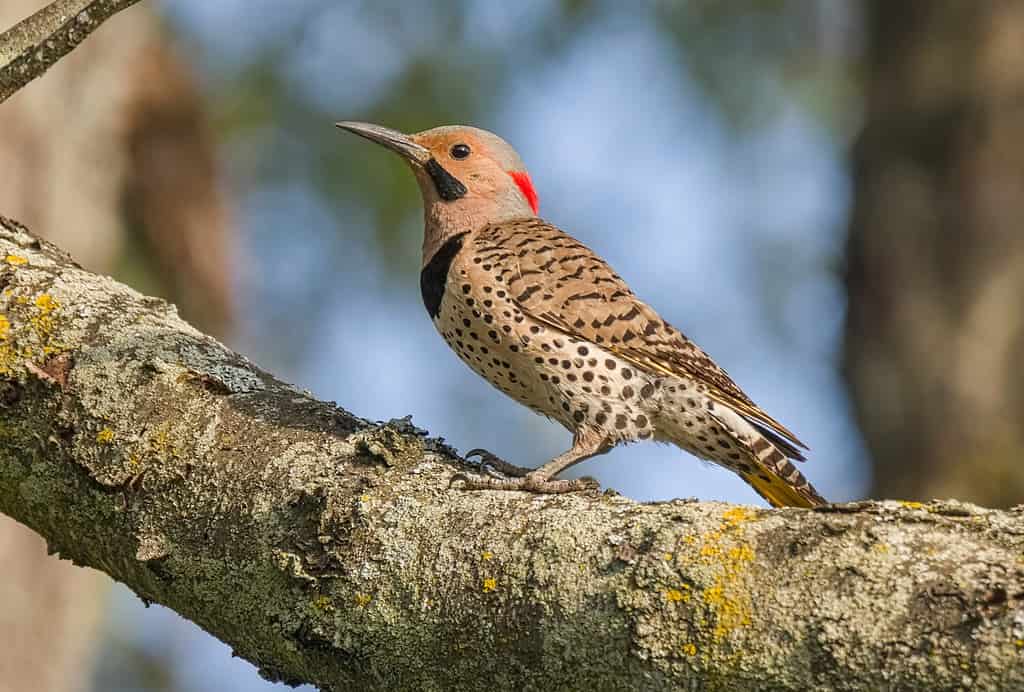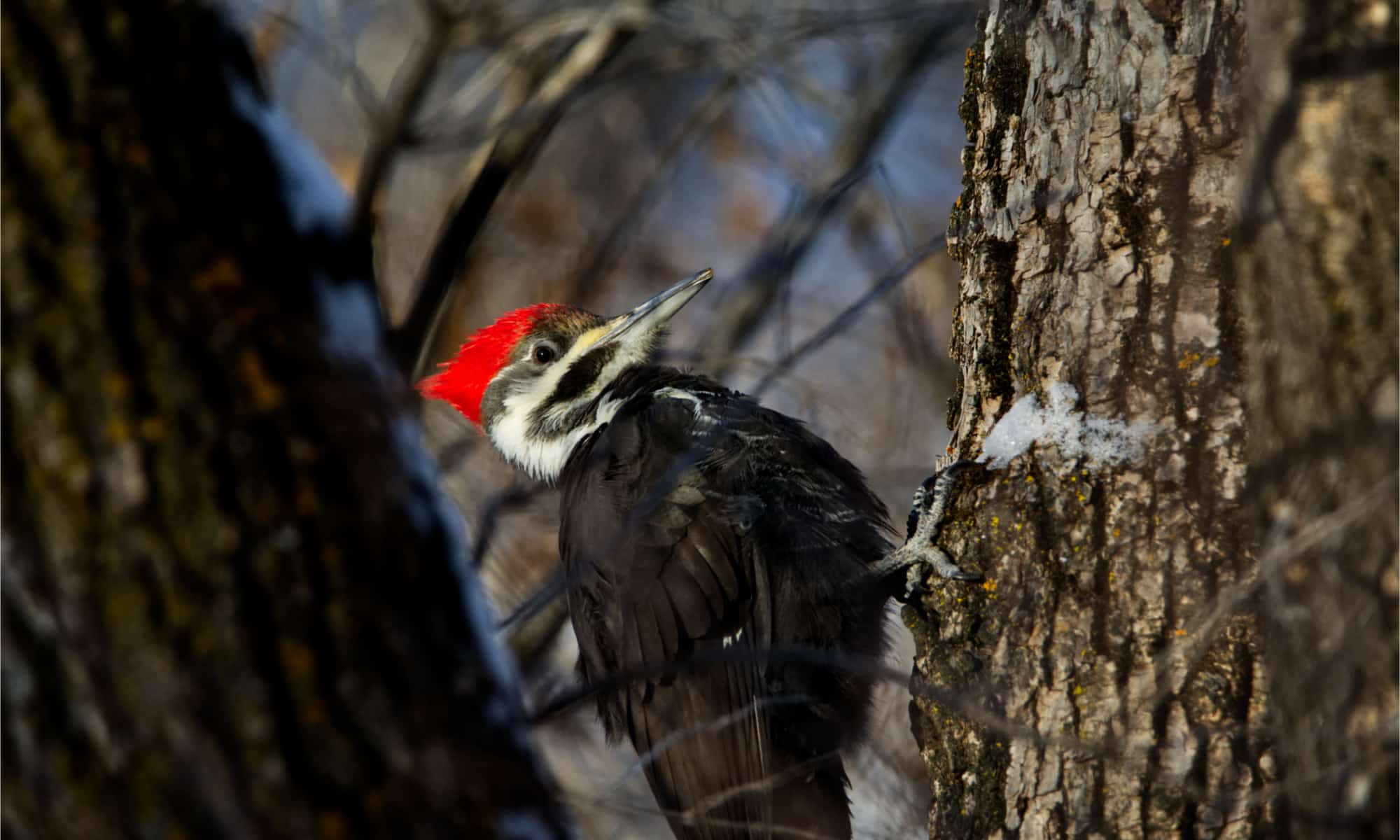There are over a dozen species of woodpeckers found in Canada. However, most of them are on the smaller side. There are two particularly large woodpeckers, though. These two species may both be large, but they are extremely different from each other.
For instance, one feeds in the trees, while the other sucks ants from the ground. Keep reading to learn about these incredibly unique species.
1. Pileated Woodpecker

This woodpecker species is absolutely massive, making it the largest woodpecker found in Canada.
©Vlad G/Shutterstock.com
The Pileated Woodpecker is the largest woodpecker species in Canada, with a body length of 16 to 19 inches (40 to 49 centimeters) and a wingspan of 26 to 30 inches (66 to 76 centimeters). It is a marvelous representative of the Picidae family thanks to its huge size and magnificent red crest.
They’re found throughout North America. In Canada, the Pileated Woodpecker can be found in a wide range of habitats, making it one of the more adaptable woodpecker species in the country. They are commonly found in mature and old-growth forests, deciduous and mixed forests, as well as swampy areas, and riparian zones.
Simply put, you can find them just about anywhere.
These woodpeckers do prefer areas with large, mature trees. This is because these trees provide an ample supply of their primary food source – wood-boring insects. Moreover, they’re particularly fond of trees that are decaying, as these tend to be the easiest place for them to find food. Additionally, they help control the insect population.
Canada offers a diverse range of habitats that cater to the Pileated Woodpecker’s needs, from the boreal forests in the north to the temperate rainforests in the west and the mixed woodlands in the east.
As a result, these woodpeckers can be found in many provinces across the country, including British Columbia, Alberta, Ontario, Quebec, and parts of the Maritime provinces.
Vocalizations
The Pileated Woodpecker has some impressive vocalizations, as well. Their call is loud and can be heard from a considerable distance. Their most recognizable call is the “kuk” and “kik” sounds, which they use to claim their territory.
You may also spot these birds engaging in drumming displays, which occurs when they beat on a tree with their powerful beak. They prefer resonating surfaces for drumming, like hollow trees or wooden surfaces. This allows the drumming sound to echo.
Breeding
During the breeding season, these Pileated Woodpeckers form pairs. They work together to build nests in cavities. They prefer large, rotten trees for their nests. The excavation process can take several weeks. They must dig out the tree trunk to create a suitable nesting area.
These nesting cavities are also essential for other bird species and wildlife that utilize them after the Pileated Woodpeckers move on.
2. Northern Flicker

You’ll be surprised to find out that the Northern Flicker actually consumes most of its food on the ground.
©Fiona M. Donnelly/Shutterstock.com
The Northern Flicker is another somewhat large species that is found in North America. You can find it in many areas of Canada. They’re known for their distinctive appearance and vocalizations.
The Northern Flicker is a medium-sized woodpecker, measuring about 11 to 14 inches (28 to 36 centimeters) in length, with a wingspan ranging from 16 to 20 inches (41 to 51 centimeters).
These creatures display a variety of hues. Specifically, their dorsal region features a pale brown shade marked with dark stripes or dots, and a black crescent shape adorns their chest. Moreover, their ventral wings showcase a brilliant, lively yellow tone, facilitating their recognition. Additionally, their tail feathers are a conspicuous white color, especially when they take flight.
One of the most striking characteristics of the Northern Flicker is its pattern of spots or dots on its back, referred to as “ladder-back” markings.
This pattern is supposed to help it camouflage. However, it also helps identify this bird, as it is a pretty unique coloration.
This woodpecker is pretty adaptable, as they are found across a diverse range of habitats across Canada. You’ll find them in both rural and urban settings. They simply follow the food sources and nesting sites. You’ll notice them in forests, parks, gardens, and suburban areas. Birdwatchers may have an easier time spotting them as they don’t prefer as much seclusion as other species.
Unlike other woodpeckers, Northern Flickers mostly feed on the ground. Although they do have a strong beak that can pry insects out of wood, their diet actually consists of ants and beetles. You’ll find them foraging on the ground and eating ants with their long, barbed tongues.
Vocalizations
Both males and females vocalize, including a loud and rhythmic “wick-a, wick-a, wick-a” call, which is commonly heard during the spring and summer months.
Breeding
You may be able to spot the Northern Flickers engaging in courtship rituals that involve elaborate aerial displays. They’ll fly high into the air and perform impressive acrobatics.
Once a mate is chosen, the pair collaborates to build their nest cavity, typically in a dead tree or a snag. However, in more urbanized areas, they may use nesting boxes or even the exterior walls of buildings for this purpose.
Their nesting cavities are very shallow, which is why they are able to live in suburban areas.
Summary of the Top 2 Largest Woodpeckers Found In Canada
| Number | Woodpecker |
|---|---|
| 1 | Pileated Woodpeckers |
| 2 | Northern Flicker |
Thank you for reading! Have some feedback for us? Contact the AZ Animals editorial team.








